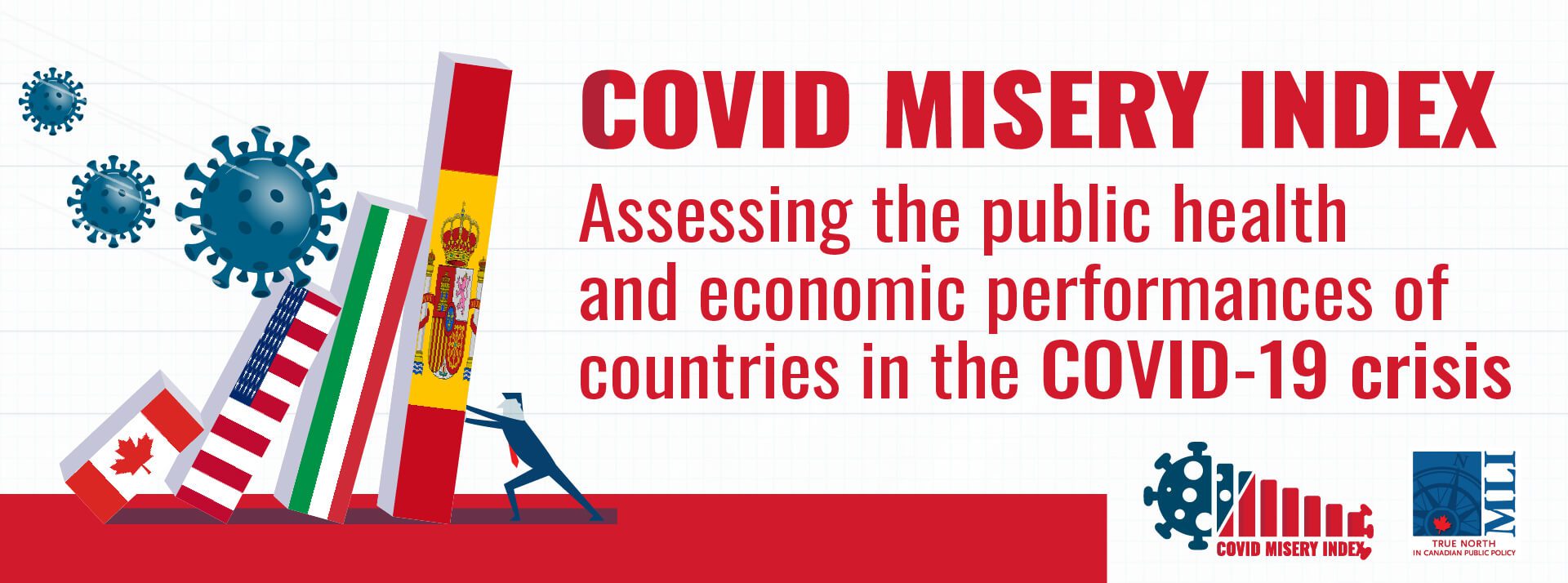View the full, updated COVID Misery Index here. Download the data for the March 19 update here. For more information, including a full methodology and analysis of the initial COVID Misery Index, click here, and view the original, non-updated Misery Index here.
MLI COVID Misery Index Weekly Update (March 19, 2021): MLI’s COVID Misery Index provides a means of examining how Canada is managing the pandemic by examining data related to the disease impacts, response measures, and economic burden, and comparing our performance against 14 similar countries. We will continue to monitor the ‘misery’ that has been wrought by COVID-19 by examining how the disease, and the responses to it, are evolving, and report developments in weekly updates of the Index. The updates will include data related to disease and response cumulative from the past four weeks and from the previous week. Economic data will be updated monthly.
While the very top and very bottoms of the Index remain stable, there was movement in this first update. Japan and Sweden swapped positions, moving to 4th and 5th respectively. Switzerland and the Netherlands both benefitted in the overall rankings from a significant drop in Germany’s performance. Germany slipped from 6th to 8th. France and Italy also swapped their overall positions, though their low respective ranks of 12th and 13th are quite close with one another.
While Canada remains stagnant in the overall rankings, it improved slightly against the performance of its peers with respect to disease misery and fell to the bottom of all countries measured in terms of its response misery. With lagging vaccinations, poor testing, and persistent lockdowns, Canada’s response stands out for being remarkably inefficient.
Four Week Overview
Disease Misery
Over the past four weeks, COVID-19 has hit Italy and France particularly hard. Both countries had significant increases in cases over the past 28 days (although not as high as Sweden) as well as high rates of hospitalizations and ICU admissions. Both countries also experienced high rates of COVID-19 fatalities. Canada has fared better with regard to the spread and impact of the disease, with lower caseloads, hospitalizations and fatalities attributable to the virus. However, our excess deaths (that is, total number of deaths compared to the same four weeks last year) is considerably higher than other countries, suggesting that the focus on COVID-19 is adversely impacting the health of Canadians in other ways. The countries that have had very low disease misery over the past four weeks are Japan, Australia and Norway – countries that have generally done well in the overall index and continue to keep the spread of the disease, and serious illness and mortality resulting from it, low.
Response Misery
While the disease itself has not spread as quickly, nor have the consequences been as severe, Canada’s COVID-19 misery is highest among our comparison countries. In short, governments’ responses in Canada have brought on high rates of misery. Testing in Canada, relative to caseloads, has been poor, and our vaccination roll-out in terms any or full vaccinations lags behind many of our peers. The Netherlands and Germany are also experiencing high response misery – both countries have had very stringent lockdowns, while their vaccine roll-out has been a bit slower than average. Over the past four weeks, the Switzerland and the United States have had the lowest response misery in our group of comparator nations. The US is dispensing vaccines very quickly while simultaneously reducing some of their more stringent public health measures. Switzerland has also been rolling out vaccines at an impressive rate and has relatively less stringent public health measures compared other nations.
The Past Week
Disease Misery
Over the past week high rates of new cases of COVID-19 have been reported in France, Italy and Sweden. France and Italy are also experiencing high rates of hospitalization, ICU admissions, and deaths, while Sweden’s rates of these metrics are considerably lower; as a result, its disease misery falls below that of Italy and France. Japan, Norway and Australia continue to lead the world in managing and limiting the spread of this disease and the serious health effects that can follow.
Canada’s performance to manage the disease itself remains good. There are relatively low numbers of new cases, and attendant low rates of hospitalization, ICU admissions and deaths from COVID-19. Worryingly, however, is the very high rates of excess deaths in Canada, suggesting that our attention to COVID-19 is resulting in significant increases in other causes of mortality. This is a trend that bears close observation going forward. If Canadians are systematically not accessing or receiving necessary health care for non-COVID conditions, this trend will persist long after the pandemic ends.
Response Misery
Canada’s response to COVID-19 over the past week remains the worst in our group of comparison countries. Stringent public health measures and low rates of full vaccinations remain a particular concern, although it should be noted that Canada has made up some ground in the past week in terms of getting at least one vaccination dose delivered to the population. This approach is consistent with the strategy used by some provinces to delay second doses so that a greater number of people can receive a single dose. Other countries with high rates of response misery include Japan and Germany.
The United States had last week’s best COVID-19 response, with very high rates vaccination as well as relatively low rates of stringency. These two factors are likely related: as those most vulnerable receive the vaccine, the risk of relaxing public health measures decreases.
Richard Audas, Faculty of Medicine, Memorial University of Newfoundland





